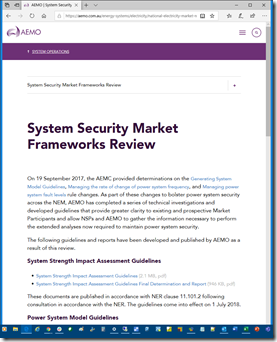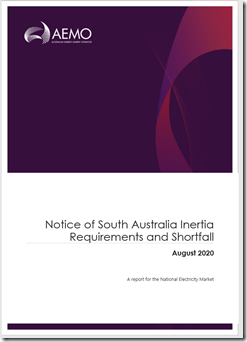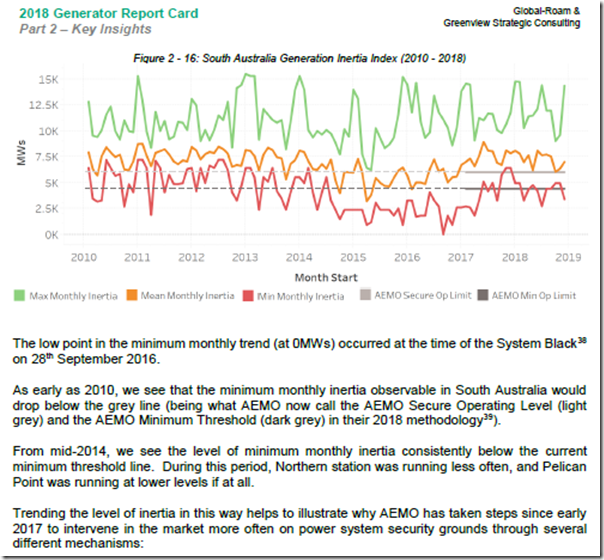Most of the attention has been understandably focused on the release of AEMO’s 2020 Electricity Statement of Opportunities today, including its forecasts that the forecast that might be summed up as ‘not so bad’ compare to prior year forecasts – though Allan O’Neil will unpick more of what it means in the coming days.
———
However, one thing that did jump out at me in one of the many newsletter feeds that arrived today was specifically related to levels of inertia in the South Australian region of the NEM.
(A) Some background to levels of inertia in the South Australian region
As time permits we’ll flesh out this page in the WattClarity Glossary which has been added to discuss inertia, but for now:
1) the page links to a useful reference prepared by NREL in the USA which might be of use to some people;
2) In simple terms remember that the lower the level of inertia in a grid, the higher the Rate of Change of Frequency (i.e. ROCOF) in response to some large contingency event, like the loss of a large generator, or large segment of load. This operates instantaneously (i.e. more quickly than the operation of the current Frequency Control Ancillary Services arrangements).
(A1) Back in September 2016
We’ve previously posted, and linked to, various articles about the SA System Black which occurred on 28th September 2016.
In response to that event (and the reviews that followed – including the Finkel Review) many changes have been made, including how levels of inertia in the grid are actually managed. One of the changes made was the introduction of both a ‘Minimum Operating Limit’ and a ‘Secure Operating Limit’ for aggregate level of inertia in all regions of the NEM.
In the preparation of our Generator Report Card 2018, developed in conjunction with Greenview Strategic Consulting, we explored a number of different aspects of ‘Emerging Challenges for managing system security’ (as Theme 9 within Part 2 of the 180-page Analytical Component).
1) The GRC2018 was released on 31st May 2019
2) Drawing from this widely-read report, I posted about ‘Calculated level of inertia in the South Australian grid, supplied by synchronous generation plant’ on 12th August and included this image from the GRC2018:
The chart showed a trend of the (reverse-engineered by GVSC) monthly range of instantaneous provision of inertia (measured in ‘megawatt seconds’ (i.e. MWs) in the grid “naturally” provided by synchronous generation in each of the regions of the South Australian region – it’s p33 of part 2 for those who have their copy).
Whilst these numbers end at the commencement of 2019 (something we’ll look to update in the next release of the Generator Report Card), it’s useful to keep these numbers in mind in relation to what the AEMO published today…
(A2) Islanding from 31st January 2020
I had previously written about how it seemed clear that South Australia ‘dodged a bullet’ in the aftermath of the islanding which occurred on 31st January 2020 (the 4th Headline Event).
1) There was a remarkable cessation to the extremes in weather (heat, bushfire, etc) which had besieged the NEM in the weeks rolling right into the transmission outage, but ceasing almost at the same instant the Heywood interconnector was severed.
2) This (and the absence of other major physical calamity) gave the AEMO some much needed breathing space (and a lot of good luck!) to ensure that the South Australian region was not pushed beyond its physical limits in the weeks immediately afterwards when it was running with less breathing room than normal.
That’s not to dismiss the financial pain felt by a broad section of the South Australian grid were burnt by high FCAS costs which added a very unpleasant surprise to (including some providers of FCAS services via Demand Response aggregators, we hear).
Hence it’s not really a surprise to see work that has followed – like the report we see today – which specifically focuses on the level of inertia required in the South Australian region when it is islanded.
(B) What the AEMO published
The AEMO newsletter pointed me to the following:
|
Web Page for the ‘System Security Market Frameworks Review’ within which was the…. |
’2020 Notice of South Australia Inertia Requirements and Shortfall’ 24-page PDF |
 |
 |
Click on the images above to link to the relevant pages
I’ve just flipped through this evening, but this paragraph (from p3) did jump out at me:
While the minimum threshold level of inertia remains at 4,400 megawatt-seconds (MWs), the secure operating level of inertia requirement has changed. In current and forecast power system conditions, without more fast frequency response (FFR), the inertia required to operate South Australia securely as an island is calculated to be at least 7,605 MWs in 2020-21 and 14,390 MWs in 2021-22. Installing the quantity of synchronous machines needed within South Australia to meet this requirement is not feasible.
We’ll need to think through the implications of this for our clients, and what we else we can do to help – both in terms of the fast approaching summer 2020-21 but also further into the future….



It’s almost like all the claims of the ability to have 50% or greater generation from renewables were lies and aren’t possible in the real world.
Meanwhile, no one in their right mind is going to build synchronous generation when the government is literally funding renewables to compete with you.
Maybe the operative sentence is “without fast frequency response”
It’s almost like you didn’t read the AEMO report in question at all, or the AEMO RIS, which spells out exactly how AEMO plans to manage the system above 50% renewables. AEMO’s butt is on the line with system security and reliability and accordingly it manages the system and forecasts the future conservatively – do you really think they’re lying?
And you’re right, no one in their right mind is going to build syncronous generation, they’re going to build batteries to supply FFR, because that’s exactly what AEMO is saying is needed (in the specific situation being discussed here, which is securely managing SA as an island).
Batteries don’t provide inertia. The only way to keep the lights on is to have an oversupply of fossil fuel generation but AEMO won’t say that because they are captured by green zealots.
The way to manage an islanded South Australia is to rebuild the Port Augusta coal plant.
Hi Paul,
Can you expand on your comment:
“That’s not to dismiss the financial pain felt by a broad section of the South Australian grid were burnt by high FCAS costs which added a very unpleasant surprise to (including some providers of FCAS services via Demand Response aggregators, we hear).”
Is this referring to this high FCAS lower costs borne by customers in SA, or something else that occurred?
I’m interested in the implications for the contingency plans and constraints that might be needed to protect against an interconnector trip during high rooftop PV output.
With only 500 MW demand, and the NSW-SA interconnector rated at 800 MW, that’s a big frequency whack.
Big risk for rooftop solar trips, big risk that existing inertia won’t be enough to catch it.